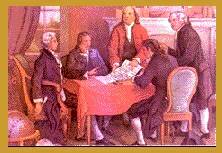|
1.1 The Continental Congress
On September 5, 1774, delegates from all the colonies except Georgia got together at Philadelphia, in the First Continental Congress. They adopted resolutions protesting against the policies pursued by the British government. They also resolved to cut off all trade with England until the repeal of the unacceptable taxes and trade regulations of the colonial government.
All 13 colonies were represented at the Second Continental Congress, convened at Philadelphia on May 10, 1775. This occurred after an open combat broke out between colonial "minutemen" and British troops at Concord and Lexington. Since warfare was on, the Congress assumed the role of a provisional government; in order to coordinate American efforts. On June 14, a continental army was created by the Congress, which then selected George Washington as commander-in-chief. As time passed, the Congress became more radical and delegates from several colonies were ready to vote for independence. Thus Richard Henry Lee of Virginia proposed the following resolution on June 7, 1776:
""Resolved, That these United Colonies are, and of right ought to be, free and independent States, that they are absolved from all allegiance to the British Crown, and that all political connection between them and the State of Great Britain is, and ought to be, totally dissolved.""

Exhibit 1.1
The Declaration Committee
1.1a The Declaration of Independence
On June 11,1776, the Congress appointed Thomas
Jefferson, Roger Sherman, Benjamin Franklin, Robert R. Livington
and John Adams, to draw up a Declaration of Independence.
Jefferson who wrote the draft, was deeply influenced by the social
contract philosophy of John Locke. In his Two Treatises on
Government, Locke defended the rights of parliament in the struggle
against the "divine right" of kings. Locke believed that man had
the natural rights to life, liberty and property.
Therefore, to protect these, man formed a political community. The
aim of the government in a community was to make laws to secure
these rights for men. Locke insisted that a good government could
only exist "By the consent of the governed." Besides, the
people had the right to abolish and establish a new government,
when the existing one threatened life, liberty and property. The
Declaration of Independence thus was subdivided under the four captions:
the law of nature, the rights of man, the role
of government, and the justification of revolution. After
a few changes made by Adams and Franklin it was presented to the
Congress and the Thirteen Colonies were declared free and independent
states under the name of the United States of America, on
July 4, 1776.
1.1b State Constitutions
All the states adopted constitutions by 1780. Each of the new constitutions were written documents. The state governments followed the patterns of colonial government. However, they made frequent references to popular sovereignty, natural rights and the separation of powers. As they had recently revolted against loyalty, executive power was greatly curtailed. Greater power was conferred on the legislative bodies, especially on the Lower House since it was a greater representative of the people. However property qualifications for voting, were imposed in all the state constitutions.
|
Index
1.0 -
Introduction
1.1 The Continental Congress
1.2
The Articles of Confederation
1.3 The Constitutional Convention
1.4 Key Concepts in the Constitution
1.5 Summary of the Constitution
1.6 The Debate over Ratification
1.7 The Amendment Process
1.8 The Bill of Rights
1.9 Subsequent Amendments (1789-1992)
Chapter 2
|